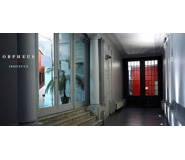ORCiM Seminar 2013
A ‘script’ as PDF and iPhoto slideshow as MP4 of my presentation at THE (RE)SOUNDING EXPERIMENT, ORCiM Seminar 2013, 20-21 February 2013, Orpheus Instituut, Ghent Belgium.
THE AUGMENTED TONOSCOPE
Lewis Sykes
Manchester Institute for Research and Innovation in Art and Design (MIRIAD),
Faculty of Art & Design, Manchester Metropolitan University,
Righton Building, Cavendish Street, Manchester, M15 6BG
Abstract
The Augmented Tonoscope is a Practice as Research PhD project working towards a deeper understanding of the interplay between sound and image in Visual Music.
The research argues for an aesthetics of sound and vibration. Sound can induce visible pattern. When physical matter is vibrated with sound it adopts geometric formations – the modal wave patterns of Cymatics. Dr Hans Jenny coined the term Cymatics (Greek: κῦμα “wave”) when he studied this subset of modal wave phenomena using a device of his own design – the ʻtonoscopeʼ. So a key method in the research has been the design, fabrication and crafting of a contemporary version of Jenny’s sound visualisation tool – a sonically and visually responsive hybrid analogue/digital instrument that produces dynamic Visual Music – the Augmented Tonoscope. By playing, recording and interacting with it, research outcomes are taking the form of artistic works for live performance, screening and installation.
A systemic series of artistic experiments has attempted to:
- explore a real-time relationship between sound and image which is direct and elementary – analogs of each other in aural and visual form;
- find an amalgam of image and sound that engages the viewer in a subtlety shifted way – a synchronisation between the senses of sight and hearing that results in a ‘co-sensing’ of a ‘co-expressiveness’, where the mind is not doing two separate things, it’s doing the same thing in two ways;
- demonstrate that sounds and images can interact with, influence and shape each other from the outset and then throughout all stages of composition, arrangement and mixing – merging the usually separate strands of audio and visual (post) production into a single workflow by devising a means and process whereby audio and visual composition occurs simultaneously.
The research has taken a hermeneutic approach – combining years of implicit practitioner knowledge with an investigation into the lineage of this practice through the ideas, approaches and techniques of inspirational artists and select research from a range of seemingly disparate disciplines that resonated with the study. Divining a congruence between these varied perspectives has crystallised a central argument to the thesis – of a harmonic complementarity between sound image. What is significant, is that since the literature doesn’t exist, an empirical demonstration through artistic practice has been a primary approach to confirm the validity of the argument.
A presentation at the fifth International ORCiM Seminar will highlight key stages of the research in looking for a cymatic visual equivalence to the auditory intricacies of melody, harmony and rhythm.
Relevant Links
The Seminar booklet is available at: http://issuu.com/jonastavernier8/docs/seminar_programme_booklet_print
The original ‘Call for Papers’ can be accessed at: http://goldenpages.jpehs.co.uk/2012/11/23/orcim-seminar-2013-the-resounding-experiment/
A ‘Critical Reflection’ of my participation in the seminar is available at my Tumblr Digital Sketchbook.
Download the slideshow as MP4 and presentation as PDF from my public WebDisk or or read on via Scribd…

